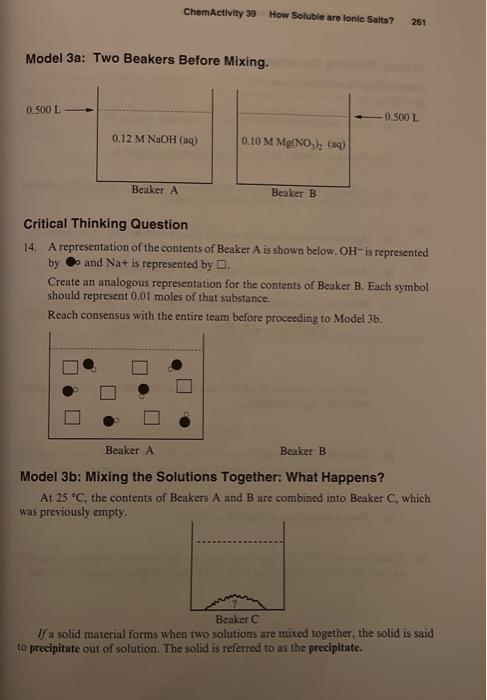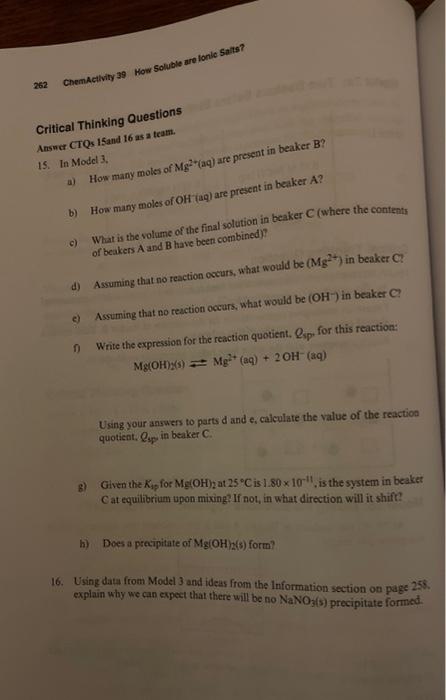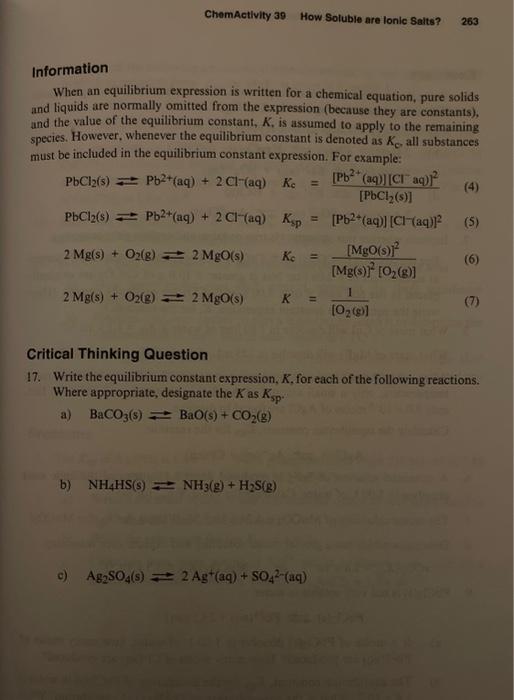Answered step by step
Verified Expert Solution
Question
1 Approved Answer
i dont understand, help plss Model 3a: Two Beakers Before Mixing. Critical Thinking Question 14. A representation of the contents of Beaker A is shown
i dont understand, help plss 


Model 3a: Two Beakers Before Mixing. Critical Thinking Question 14. A representation of the contents of Beaker A is shown below. OHis represented by C and Na+ is represented by D. Create an analogous representation for the contents of Beaker B. Each symbol should represent 0.01 moles of that substance. Reach consensus with the entire team before proceeding to Model 3b. Beaker B Model 3b: Mixing the Solutions Together: What Happens? At 25C, the contents of Beakers A and B are combined into Beaker C, which was previously empty. If a solid material forms when two solutions are mixed together, the solid is said to precipitate out of solution. The solid is referred to as the precipitate. Critical Thinking Questions Answer CTQs 15 and 16 as a teath. 15. In Model 3. a) How many moles of Mg2+(aq) are present in beaker B ? b) How many moles of OH (aq) are preient in beaker A ? c) What is the volume of the final solution in beaker C (where the contents of beakers A and B have been combined)? d) Assuming that no reaction occurs, what would be (Mg2+) in beaker C : e) Assuming that no reaction occurs, what would be (OH)in beaker C ? ) Write the expression for the reaction quotient, Qip, for this reaction: M(OH)z(s)Mg2+(aq)+2OH(aq) Using your answers to parts d and e, calculate the value of the reaction quotient, Qsp in beaker C. 8) Given the K3p for Mg(OH)2 at 25C is 1.801011, is the system in beaket Cat equilibrium upon mixing? If not, in what direction will it shift? h) Does a precipitate of Mg(OH)2(s) form? 16. Using data from Model 3 and ideas from the Information section on page 258 . explain why we can expect that there will be no NaNO3(5) precipitate formed. Information When an equilibrium expression is written for a chemical equation, pure solids and liquids are normally omitted from the expression (because they are constants), and the value of the equilibrium constant, K, is assumed to apply to the remaining species. However, whenever the equilibrium constant is denoted as Kc all substances must be included in the equilibrium constant expression. For example: PbCl2(s)Pb2+(aq)+2Cl(aq)Kc=[PbCl2(s)][Pb2+(aq)][Claq)]2PbCl2(s)Pb2+(aq)+2Cl(aq)Ksp=[Pb2+(aq)][Cl(aq)]22Mg(s)+O2(g)2MgO(s)Kc=[Mg(s)]2[O2(g)][MgO(s)]22Mg(s)+O2(g)2MgO(s)K=[O2(g)]1 Critical Thinking Question 17. Write the equilibrium constant expression, K, for each of the following reactions. Where appropriate, designate the K as Ksp. a) BaCO3(s)BaO(s)+CO2(g) b) NH4HS(s)NH3(g)+H2S(g) c) Ag2SO4(s)2Ag+(aq)+SO42(aq) Model 3a: Two Beakers Before Mixing. Critical Thinking Question 14. A representation of the contents of Beaker A is shown below. OHis represented by C and Na+ is represented by D. Create an analogous representation for the contents of Beaker B. Each symbol should represent 0.01 moles of that substance. Reach consensus with the entire team before proceeding to Model 3b. Beaker B Model 3b: Mixing the Solutions Together: What Happens? At 25C, the contents of Beakers A and B are combined into Beaker C, which was previously empty. If a solid material forms when two solutions are mixed together, the solid is said to precipitate out of solution. The solid is referred to as the precipitate. Critical Thinking Questions Answer CTQs 15 and 16 as a teath. 15. In Model 3. a) How many moles of Mg2+(aq) are present in beaker B ? b) How many moles of OH (aq) are preient in beaker A ? c) What is the volume of the final solution in beaker C (where the contents of beakers A and B have been combined)? d) Assuming that no reaction occurs, what would be (Mg2+) in beaker C : e) Assuming that no reaction occurs, what would be (OH)in beaker C ? ) Write the expression for the reaction quotient, Qip, for this reaction: M(OH)z(s)Mg2+(aq)+2OH(aq) Using your answers to parts d and e, calculate the value of the reaction quotient, Qsp in beaker C. 8) Given the K3p for Mg(OH)2 at 25C is 1.801011, is the system in beaket Cat equilibrium upon mixing? If not, in what direction will it shift? h) Does a precipitate of Mg(OH)2(s) form? 16. Using data from Model 3 and ideas from the Information section on page 258 . explain why we can expect that there will be no NaNO3(5) precipitate formed. Information When an equilibrium expression is written for a chemical equation, pure solids and liquids are normally omitted from the expression (because they are constants), and the value of the equilibrium constant, K, is assumed to apply to the remaining species. However, whenever the equilibrium constant is denoted as Kc all substances must be included in the equilibrium constant expression. For example: PbCl2(s)Pb2+(aq)+2Cl(aq)Kc=[PbCl2(s)][Pb2+(aq)][Claq)]2PbCl2(s)Pb2+(aq)+2Cl(aq)Ksp=[Pb2+(aq)][Cl(aq)]22Mg(s)+O2(g)2MgO(s)Kc=[Mg(s)]2[O2(g)][MgO(s)]22Mg(s)+O2(g)2MgO(s)K=[O2(g)]1 Critical Thinking Question 17. Write the equilibrium constant expression, K, for each of the following reactions. Where appropriate, designate the K as Ksp. a) BaCO3(s)BaO(s)+CO2(g) b) NH4HS(s)NH3(g)+H2S(g) c) Ag2SO4(s)2Ag+(aq)+SO42(aq) 


Step by Step Solution
There are 3 Steps involved in it
Step: 1

Get Instant Access to Expert-Tailored Solutions
See step-by-step solutions with expert insights and AI powered tools for academic success
Step: 2

Step: 3

Ace Your Homework with AI
Get the answers you need in no time with our AI-driven, step-by-step assistance
Get Started


